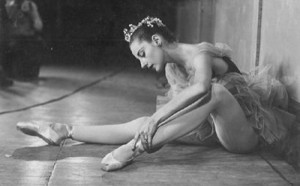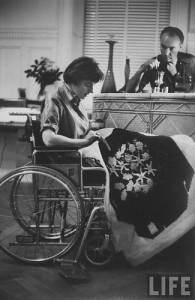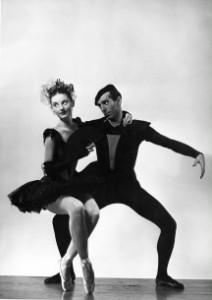 I finally got a chance last week to see Nancy Buirski’s Afternoon of a Faun: Tanaquil Le Clercq, a documentary about the American ballerina that aired a few months ago on PBS and is now available on DVD. It’s an extraordinarily fine piece of work, in large part because it contains more than enough film of Le Clercq performing on stage and in the studio to give the viewer a clear sense of her uniquely photogenic quality.
I finally got a chance last week to see Nancy Buirski’s Afternoon of a Faun: Tanaquil Le Clercq, a documentary about the American ballerina that aired a few months ago on PBS and is now available on DVD. It’s an extraordinarily fine piece of work, in large part because it contains more than enough film of Le Clercq performing on stage and in the studio to give the viewer a clear sense of her uniquely photogenic quality.
I wrote at length about Le Clercq in All in the Dances: A Brief Life of George Balanchine:
Long-legged and long-necked to the point of gawkiness, with delicately chiseled features and a gamine smile, Tanaquil Le Clercq, known to all as “Tanny,” was a Balanchine ballet come to life. “Like a lean Giacometti, she reflected modern art,” wrote Allegra Kent, who danced with her in Balanchine’s Divertimento No. 15. Born in 1929, she was the first great dancer to have studied exclusively at the School of American Ballet, and by the time she made her professional debut in The Four Temperaments, she was fully formed. Tallchief [Maria Tallchief, Balanchine’s third wife] enviously described her as “a coltish creature who still had to grow into her long, spindly legs. Those legs went on forever—it seemed as if her body could barely sustain them. She had the long, willowy look of a fashion model, dressed stylishly in long skirts and sweaters, and had a lovely presence….Tanny didn’t have a formal education, yet she was articulate, witty, and chic.” A few of her performances were filmed, and in them one can see “the scissor legs, the vehement energy, the regal spine, the expansive upper body, the wit, the chic, the joy in movement” to which her friend Holly Brubach paid tribute after Le Clercq’s death in 2000. Jerome Robbins fell in love with her at first sight, and for a while they were all but inseparable. Balanchine teamed them to memorably comic effect in Bourrée Fantasque, while Robbins immediately began making dances of his own for her. “All the ballets I ever did for the company,” he later confessed, “it was always for Tanny.”
But Balanchine’s eye had already started to wander—as had Tallchief’s. They agreed to separate after the London season (their marriage was subsequently annulled), and no sooner did NYCB return to Manhattan than Balanchine began seeing Le Clercq in public. “I just love you to talk to, to go around with, play games, laugh like hell, etc.,” she told Robbins in a letter. “However, I’m in love with George. Maybe it’s a case of he got here first.” Devastated by what he saw as her betrayal, Robbins made The Cage, a chillingly angry portrait of a tribe of insect-women who kill the men with whom they mate. And though Tallchief remained the prima ballerina of New York City ballet for a few years more, it was Le Clercq for whom Balanchine made La Valse (1951, music by Ravel), a darkly unsettling vignette about a beautiful young girl who encounters a black-clad man at a party. He offers her a pair of black gloves into which the girl heedlessly plunges her hands. Then they waltz together with mad abandon until she collapses and dies.
La Valse ranks among Balanchine’s most strikingly personal creations, one with which Le Clercq would forever after be identified. But it was a bizarre present to offer his latest muse, whom he married at the end of 1952: a ballet in which he envisioned her premature death. What happened to her in real life would be immeasurably more shocking….
 Le Clercq contracted polio in 1956, when she was just twenty-six years old. She was one of the last people in America to develop that dread disease before Jonas Salk’s vaccine made it a thing of the past. It left her paralyzed from the waist down, and she never danced again. At first Balanchine nursed her devotedly, but in due course he began to see other women, and eventually he divorced her to pursue Suzanne Farrell.
Le Clercq contracted polio in 1956, when she was just twenty-six years old. She was one of the last people in America to develop that dread disease before Jonas Salk’s vaccine made it a thing of the past. It left her paralyzed from the waist down, and she never danced again. At first Balanchine nursed her devotedly, but in due course he began to see other women, and eventually he divorced her to pursue Suzanne Farrell.
It isn’t unusual for great artists—and Tanaquil Le Clercq was a very great artist, the foremost American classical dancer of her generation—to die young. What makes her story so intensely poignant is that unlike Mozart or Keats or Robert Johnson, she lived on after tragedy struck her. A beautiful, determined woman of wit and intelligence, she managed to make an independent life for herself, and was much loved by the many friends who talk about her in Afternoon of a Faun. But there was no getting around the terrible fact that she had been deprived in youth both of her occupation, at which she was supremely gifted, and the love of her life, to whom she had been passionately devoted. I find that more haunting than I can possibly say.
In a way, it is scarcely less tragic that Le Clercq was forced to stop dancing when she did. The great dance boom of the Sixties was only a few short years away, and the next generation of Balanchine dancers, Farrell most prominent among them, would have the opportunity to appear in films and telecasts that allow later generations to see for themselves why they were so greatly admired. Not so Le Clercq, who can only be seen in a handful of kinescopes, of which this one, a 1956 CBC telecast of Balanchine’s Concerto Barocco that was released on DVD earlier this year, suggests what she was and why it mattered. So, too, does Afternoon of a Faun, which is one of the saddest and most beautiful documentaries I know.
 I was born in the year that Le Clercq stopped dancing, and I never met her. But not long before she died in 2000, I happened to see her sitting in her wheelchair on the promenade of the New York State Theater, mere paces away from an enlarged photo on the wall that showed her dancing gaily with Robbins in Bourrée Fantasque. With her white hair and pale, wrinkled skin, she looked like a chic ghost. A few months later I attended her memorial service, and felt, like everyone else who came to the State Theater that dark day, that I had somehow lost a friend.
I was born in the year that Le Clercq stopped dancing, and I never met her. But not long before she died in 2000, I happened to see her sitting in her wheelchair on the promenade of the New York State Theater, mere paces away from an enlarged photo on the wall that showed her dancing gaily with Robbins in Bourrée Fantasque. With her white hair and pale, wrinkled skin, she looked like a chic ghost. A few months later I attended her memorial service, and felt, like everyone else who came to the State Theater that dark day, that I had somehow lost a friend.
* * *
The trailer for Afternoon of a Faun:
